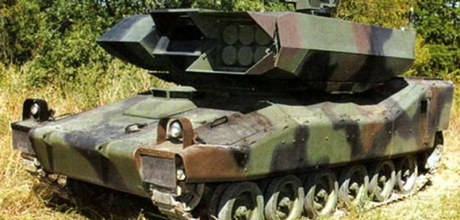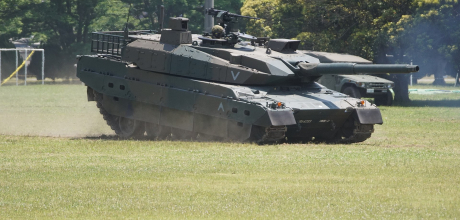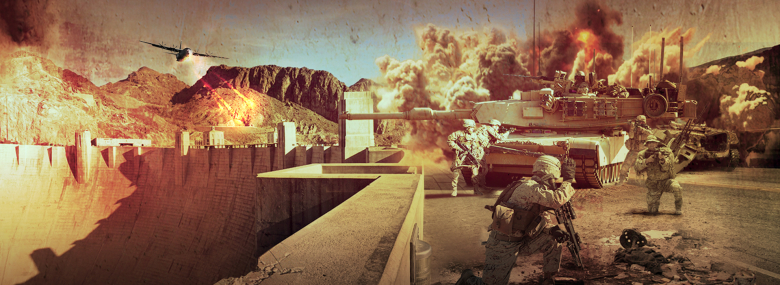
Commanders!
Everybody knows about the successful armored vehicles of history; Sherman, T-34, Abrams... you name it. But, for every such an excellent design, you have dozens, if not hundreds of other vehicles that did not make it or, worse yet, ended up being really terrible. In this series of articles, we’re going to take a look at the most infamous examples, albeit often for different reasons and we are going to be starting with a great (or, not so great, depending how you look at it) example – the Indian Arjun MBT.
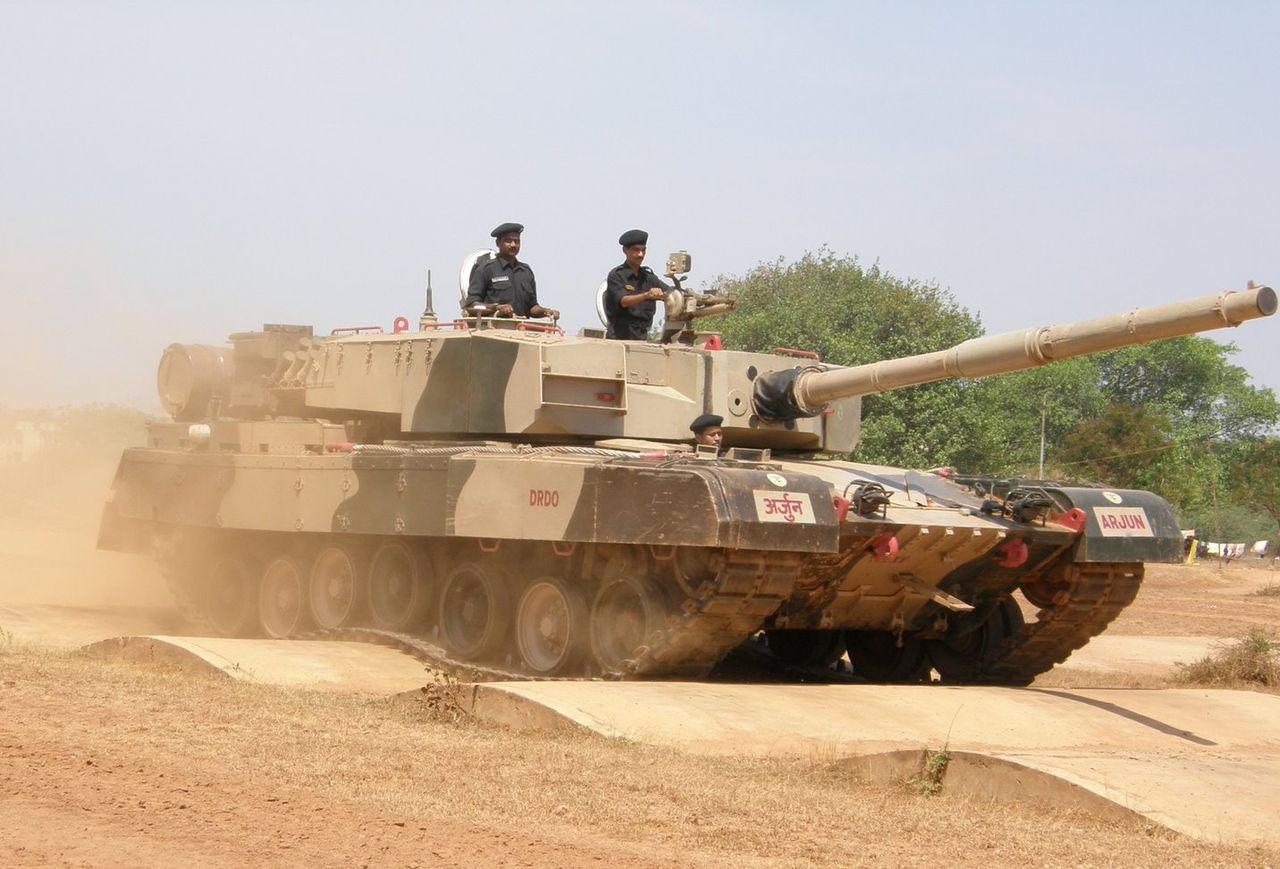
Arjun MBT
When looking at the history of failed projects – and not just armored vehicle ones, it’s usually easy to see with the benefit of hindsight where things went wrong and why did they. However, to assess matters correctly, you have to keep one thing in mind – all the decisions that led to a failure were, at the time of their making, usually very logical and justifiable. Let’s take a look at what preceded the entire ordeal.
Even though the development of Arjun started around 1971, we have to start at the beginning – in 1947, when India gained independence from the British Empire. That year marked the beginning of India’s rather interesting approach to international politics and arms. India, just free from the yoke of British domination, became fiercely anti-colonialist, and for obvious reasons. India’s first Prime Minister, Jawaharlal Nehru, also looked somewhat favorably at socialism, aligning India’s interest with the Soviet Union (that ostentatiously boasted anti-colonialism). But only to a degree – he saw full well the fate of the Central and Eastern Europe and had no desire for his country to exchange one master for another.
Another aspect was the war India was immediately forced to fight against another country that emerged from the dissolution of British India – mostly Muslim Pakistan – over the region of Kashmir, which was predominantly Muslim but its ruler was a hereditary Indian (Hindu) Maharaja. The partitioning of India left the fate of Kashmir undecided as it was such a hot potato that it threatened the entire process of peaceful parting of the two major countries. As they often do, this indecisiveness resulted in bloodshed and it is estimated that the split caused the death of roughly half a million people. In the end, India effectively won that war, but many quickly realized that the area was never far from a conflict.
And thus begun several decades of independent Indian politics where India tried to stay as neutral as possible in any conflicts between the United States of America and the Soviet Union, while, at the same time, having to invest heavily into its own military due to the fact that its main rival, Pakistan, begun to receive, starting from 1954-1955, massive amounts of American military aid due to its strategic position and the American notion that it could be a valuable ally in containing communism (unlike openly neutral India).

Sherman Mk.V
This led to an incredibly interesting assortment of weapon systems in Indian service, ranging from British and French tech to India being the single largest buyer of Soviet (and later Russian) arms since the 1980s to this day.
However, being independent during the Cold War came with a price tag. If you’re not a close ally, nobody is selling you the latest weapons technology available, even though private companies are more than happy to offer you off-the-shelf solutions or even develop tech just for you. Just not the really cutting edge. This, of course, was the case for armor acquisitions as well.
After the First Indo-Pakistani War of 1947, the Indian military was left with some aging Sherman and Stuart tanks left there at the end of the Second World War, which wasn’t really all that much and the decision to adopt a new tank, designed specifically for the terrain and weather conditions of India, was taken as early as in the 1950s. The conditions weren’t all that different from other countries, mind you, but there was one special thing an Indian tank had to do, and that was to fight in high altitudes. After all, the region of Kashmir, where a war was the likeliest, is quite mountainous. That is why the tank had to be relatively light and rugged.
During the 1950s, the Indians made several attempts to purchase modern tanks, either by buying existing stock, or to have a new tank designed for them. One of these was the Indien-Panzer, one of the first, if not the first, post-war West German tank designs by Porsche. The project was eventually unsuccessfully closed in 1955.
In the meanwhile, India kept buying:
- Shermans from the United States (200 76mm M4A1 and M4A3 variants in the 1950s)
- AMX-13 Light Tanks from France (164 between 1957 and 1958)
- Centurion tanks from the United Kingdom (220 Mk.3 or Mk.7 variants with an 84mm 20pdr gun between 1956 and 1957)
Together with the older Mk.V (75mm) Shermans, these types would form the backbone of the Indian armored forces well into the 1960s until the arrival of the Vijayanta tank. The older 75mm Shermans would later be upgraded with different guns such as the American 76mm M1A2, the Soviet 76mm D-56T from the PT-76 Light Tank or the French SA50 guns from the AMX-13. It’s worth noting that the numbers differ wildly between sources (for example, L. Kavic in his 1967 book states that India purchased as many as 150 AMX-13 tanks but as little as 30 Shermans), which is why we will be sticking to the publically available SIPRI numbers.
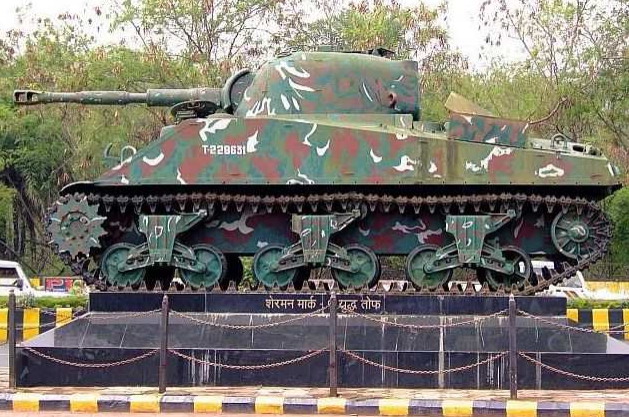
Indian Sherman re-armed with Soviet D-56T gun
These tanks would face some 460 M47 and M48 series Patton tanks, given to Pakistan by the USA between 1955 and 1965. It’s not that the USA did actively hinder India’s attempts to obtain modern military vehicles, but, for the Americans, Pakistan was far more valuable as an ally because, unlike India, it didn’t proclaim to be neutral and was, as a “bonus”, quite weak and unstable politically, which meant that the Americans were able to project their influence there much better than they would be in proud and independent India.
The reasons for this interesting assortment of vehicles can be traced, once again, to 1947, or, more specifically, to the Blackett Report. P.M.S. Blackett was a notable British scientist, who assembled a list of recommendations for India to become more self-sufficient. Despite correctly identifying Pakistan and China as the biggest threat to India as well as the need for security, Blackett actually suggested that India’s resources (little as they were) should not be depleted on major military purchases and should instead be invested into general industry improvement. Otherwise, India would become completely dependent on arms imports, which would eventually become really, really costly.
Instead, he did split the weapon systems into two categories (for a full scale war and for fighting in regional conflicts) and suggested that only obsolete, low quality weapons from military surplus sales would be used for the latter. That way, India would be able to save its resources to gradually build its underdeveloped industry. The second category affected especially the Indian Army, whereas the Indian Air Force would have access to the latest equipment. A rifle is a rifle, he argued, but there is a world of difference between a piston-powered fighter and a fighter jet.
As it often happens with good plans, the Blackett Report was widely applauded, accepted almost in entirety and then its implementation was completely botched. Some of the abovementioned principles and ideas did stick around but, simply put, the Indian military as a whole was a mess between 1947 and 1962.
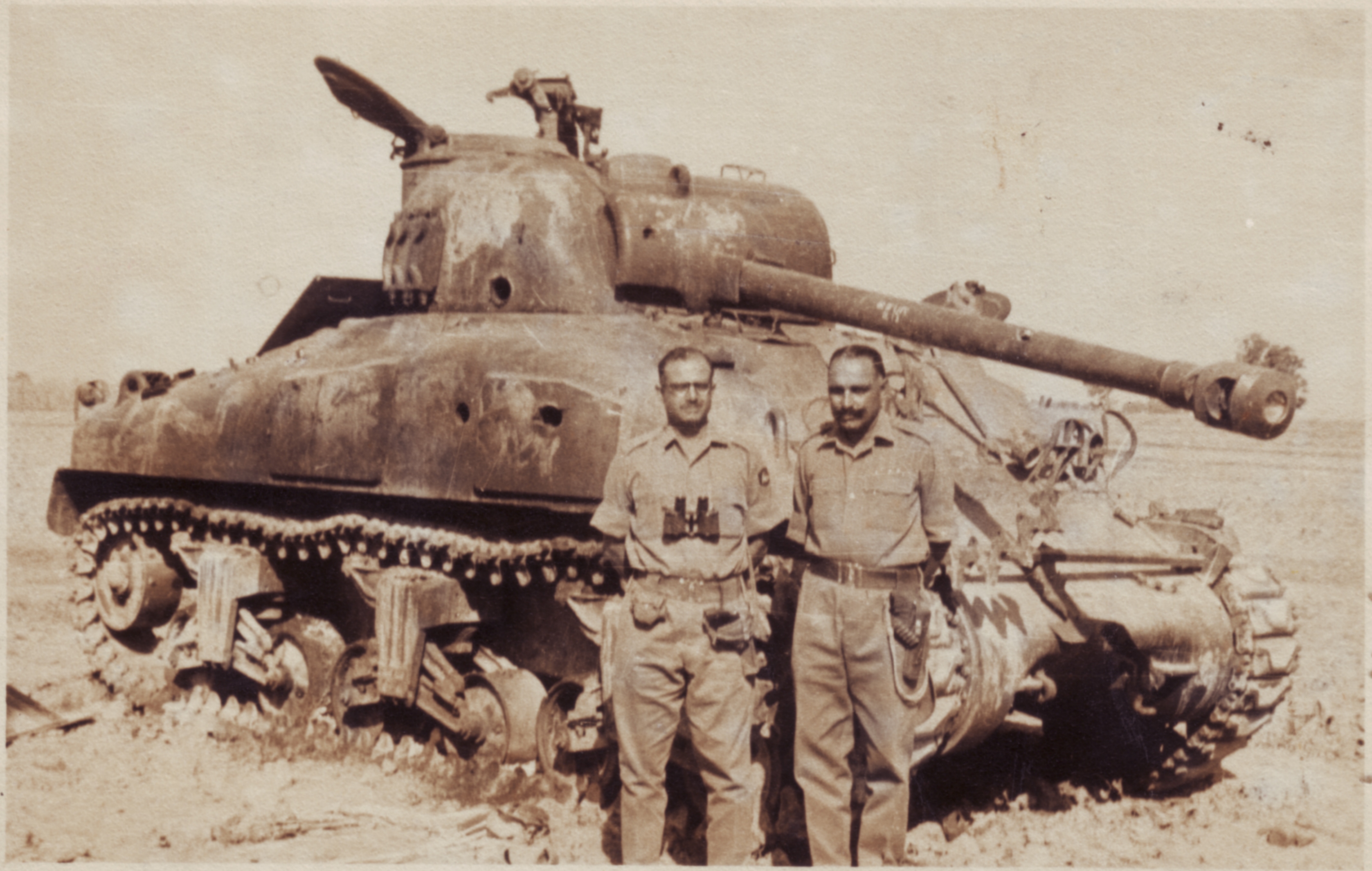
Pakistani M4A1E6 Sherman, knocked out during the 1965 war
In the 1960s, things started to heat up. The Sino-Indian war of 1962 came first and ended badly for India largely due to the fact that Nehru believed the Chinese to be peaceful as fellow members of the non-aligned movement that came from the 1955 Bandung conference. Unfortunately for him, nobody told the Chinese and, after all, what was another thousand dead soldiers next to the Great Leap Forward death toll of 20 to 40 million people. Pakistan took notice and launched another war over Kashmir in 1965, which India, who also had learned its lesson, won, but it was more of a stalemate than either side would like to admit. As for armored combat, the Indian Centurions fared pretty well against the Pakistani American-made M47s and even the old M4s took their toll on the enemy.
But, in the grand scheme of things, it was a strategic victory of India. The “independence first” approach of its military procurement was well-justified when the United States of America embargoed both sides in 1965 in order to de-escalate the conflict. India was left inconvenienced military-wise, but Pakistan, operating mostly American equipment, was effectively crippled for several years and its military expenditures reached the Indian levels only in 1968-1969, simply because there was nothing for them to buy. As for India, extremely favorable trade conditions with Britain allowed it to purchase British goods rather cheaply (in rupees), which allowed it to invest its reserves into other fields.
The history of the 1960s armor is relatively convoluted with a lot of things happening at once, but the idea of arms independence permeated the entire ordeal. It can be separated into two chapters, important for the later development of the Arjun MBT. The first and the obvious one was the adoption of the Vijayanta MBT. The Vijayanta was a modified Vickers Mk.1 export tank, which in turn was basically a discount Centurion. Despite India’s savings while trading with the British, constantly purchasing modern British equipment was not really an affordable strategy for the Indian military due to the country’s meager foreign exchange reserves and, with the lessons of independence on their mind, the Indians sought one thing that became the foundation of the trades that would follow – technology transfer.
In other words, India was looking at local license production of a modern tank. To that end, the Heavy Vehicle Factory was established in Avadi in 1961 with the goal of building the Vickers export tanks under the name Vijayanta (“Victorious”). The British agreed and even though the first 90 Vijayanta tanks were built in 1963-1964 in Britain, the rest of them were built already in India (the first tanks rolled off the assembly line in 1965) and the production took place until 1986 with roughly 2200 tanks built in total.
The Vijayanta wasn’t the world’s most cutting edge tank, but it was nothing to scoff at. While its armor was quite basic, it had a potent weapon in the form of the famous British 105mm Royal Ordnance L7 cannon that outperformed pretty much anything on the battlefield, including the earlier Pakistani Patton tanks. It was the first major success of the Indian armored vehicle industry – a truly Indian tank the country could be proud of. The tank would serve for decades until finally being retired around 2008.

Vijayanta MBT
But that alone was not enough. Fortunately for India, being not aligned in the world of the Cold War meant it could court both sides and court both sides it did because the Soviets were more than happy to sell India some of their own tanks.
The first 300 T-54 tanks were ordered directly from the Soviet Union in 1964 and delivered between 1965 and 1967, followed by more than a thousand T-55 tanks delivered from the Soviet Union, Poland and Czechoslovakia between 1968 and 1974. These would be modernized in the 1990s and would remain in service until 2011.
Even though, while looking at the dates, it’s easy to attribute the cooperation between India and the Soviet Union to the Sino-Soviet split, the cooperation between the two countries was considerably older than that (going back to the early 1950s) and with the Indian government (as well as Nehru himself) being more on the socialist side than anything, it was fairly logical that the Soviets would be interested, especially when they got to export their oil to India as well starting from 1960.
This marked the beginning of a long cooperation that practically lasts to this day as well as certain Indian fondness of former Warsaw Pact technology for its simplicity and ruggedness. This cooperation was often influenced by politics, sometimes even by a lot (such as the Soviet support of Pakistan in order to drive a wedge between it and China, or the Indian condemnation of the Soviet invasion of Czechoslovakia in 1968), but never went away.
The conclusion of this era for the Indian military came in form of the 1971 Indo-Pakistani war and the resulting establishment of the country of Bangladesh as a response to the genocide launched by the Pakistanis and their Islamist militia allies. During this genocide, the Pakistanis murdered up to three million people as well as committed crimes against humanity (such as the systematic rape of several hundred thousand Bangladeshi women and girls) and, by November, attempted a surprise attack against India.
Spoiler alert, it didn’t go well for Pakistan and the Indian military (especially the navy) handed their ass to them on a silver platter, resulting in two important things – the establishment of Bangladesh and the marked increase in India’s military and industrial confidence. The Indian Vijayanta tanks performed up to or above expectations and despite several blunders, the operations in general were quite well executed on the Indian side. The conflict also served as a validation of the decisions and strategies taken over the past decade and would encourage the Indians to continue on their path, which in turn directly led to the establishment of the Arjun program.

Indian T-55 during the 1971 war
One important thing, however, is to view the results of the 1971 war and the qualities of Indian industry etc. in the right framework. Throughout the war, the quality of Pakistani equipment and troops was very low and the Indians were not all that superior. This wasn’t a conflict between two superpowers using cutting edge tech. This was a conflict between two Third World states using relatively obsolete equipment and poorly-trained troops with bad leadership, tactics and training. The abovementioned Indian confidence was warranted, yes, but its military capability was nowhere near that of the NATO or the Soviet Union. Nevertheless, they embarked on a journey to design a modern Main Battle Tank for the 1990s (which is why it is sometimes referred to as MBT-90).
The roots of the program go back to the 1970-1974 period. The first mention of the program dates to 1970 and actually pre-dates the 1971 war, even though it picked up steam after it. The task to design it fell to the Combat Vehicle Research and Development Establishment (CVRDE) laboratory, founded between 1974 and 1975 in Avadi. What followed was a decade of research with the first prototype of the tank unveiled in 1984. The tank received the name Arjun after a prince and an archer from the ancient Indian epic, Mahabharata.
This might seem like a long time – and geopolitically, it was – but to build a tank from scratch in mere decade is, for a rather underdeveloped country, no small feat. Of course, they did not actually build from scratch. The Avadi plant had a lot of experience from building the Vijayanta and, right off the bat, the Indians apparently decided to use as many off-the-shelf solutions as possible. It seems they started off with Vijayanta and then, over the course of the decade, changed the design depending on modern trends.
The thing is, this time period saw some rapid development of tanks virtually everywhere. The Soviets were, for example, already fielding the T-72 for a while by 1975 while the Indians were largely “stuck” with the Vijayanta production and some older Soviet tech. A decade old by that point and morally even older, the Vijayanta was quite obsolete in the mid-1970s even though some attempts were made to upgrade it (notably its Fire Control System).
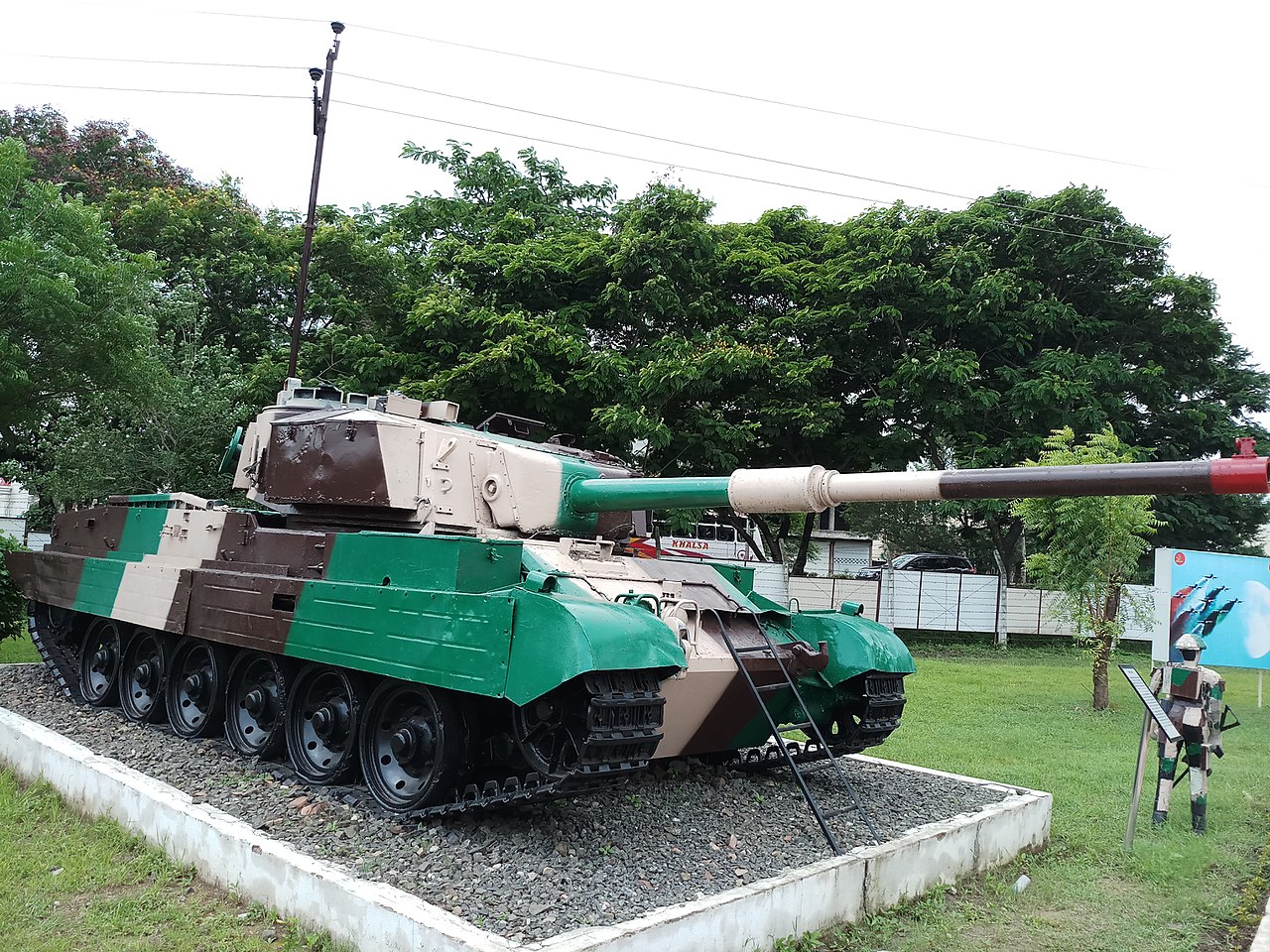
Vijayanta MBT
What the Indian designers faced was a vicious circle. They were well-aware of modern trends and technologies but by the time any such elements could be redesigned for an indigenous Indian MBT and adopted, something new came along already and the process started anew. From the initial Vijayanta-esque design, they likely went through a number of iterations until they were ready to show some results in 1984. By that time, the program did already cost 300 million rupees (roughly 30 million USD back then). That wasn’t actually bad, all things considered – the USA would squander over 300 million USD on the MBT-70 program alone.
However, there’s an old saying: “You get what you pay for.”
And what the Indians got was not great. This was partially due to the Indian experience (we’ll get to that), but also due to the fact they simply lacked the funding to finish such a project in timely manner. The oil crisis of the 1970s wreaked havoc on Indian economy – for example, between 1972 and 1974, the essential goods prices rose by 40 percent. This led to widespread unrest and meant that very little funding would be available for non-critical projects, including military ones – after all, since Pakistan (the main rival) was so soundly defeated in 1971, the idea was that this victory could be repeated at any point.
This notion in turn led to stagnation. Of special note here is the parallel with Israel – the Six-Day War was such a striking success that the Israeli forces grew complacent, allowing corruption to run rampant amongst their ranks. This directly led to the disaster that was the 1973 Yom Kippur War. Only, there was no Yom Kippur War for India because Pakistan was in the same trouble India was, so the corruption lingered on and was allowed to fester.
Another problem was the growing dependence on the communist bloc – by 1961, only 10 percent of all Indian military imports came from the Soviet Union and its satellites. By 1971, it was 90 percent and even though the terms were still technically favorable, they led to some nasty side effects for India. One example would be that even though the Soviets allowed for barter-style military trades the way they would in the Middle East (India would pay for the military tech in goods rather than in cash), they would immediately sell these goods on the free market to the west, so India was effectively competing with its own goods offered by the Soviets for lower prices.
This process was only broken in the late 1970s at a considerable cost to Indian economy, but by 1977, India was able to compete once again on the free marked with its foreign exchange reserves at a much higher level. This also marked the change in Indian military procurement strategy.
Instead of the “get whatever we can” tactic, India started acting more confidently and finally got the “competitive” way of doing things. They’d offer a contract and choose from the best option. With the communism containment doctrine more or less dead, the west would compete with the east for India’s money, which in turn opened some very interesting opportunities. For this article, the most relevant part was the cooperation with West Germany.
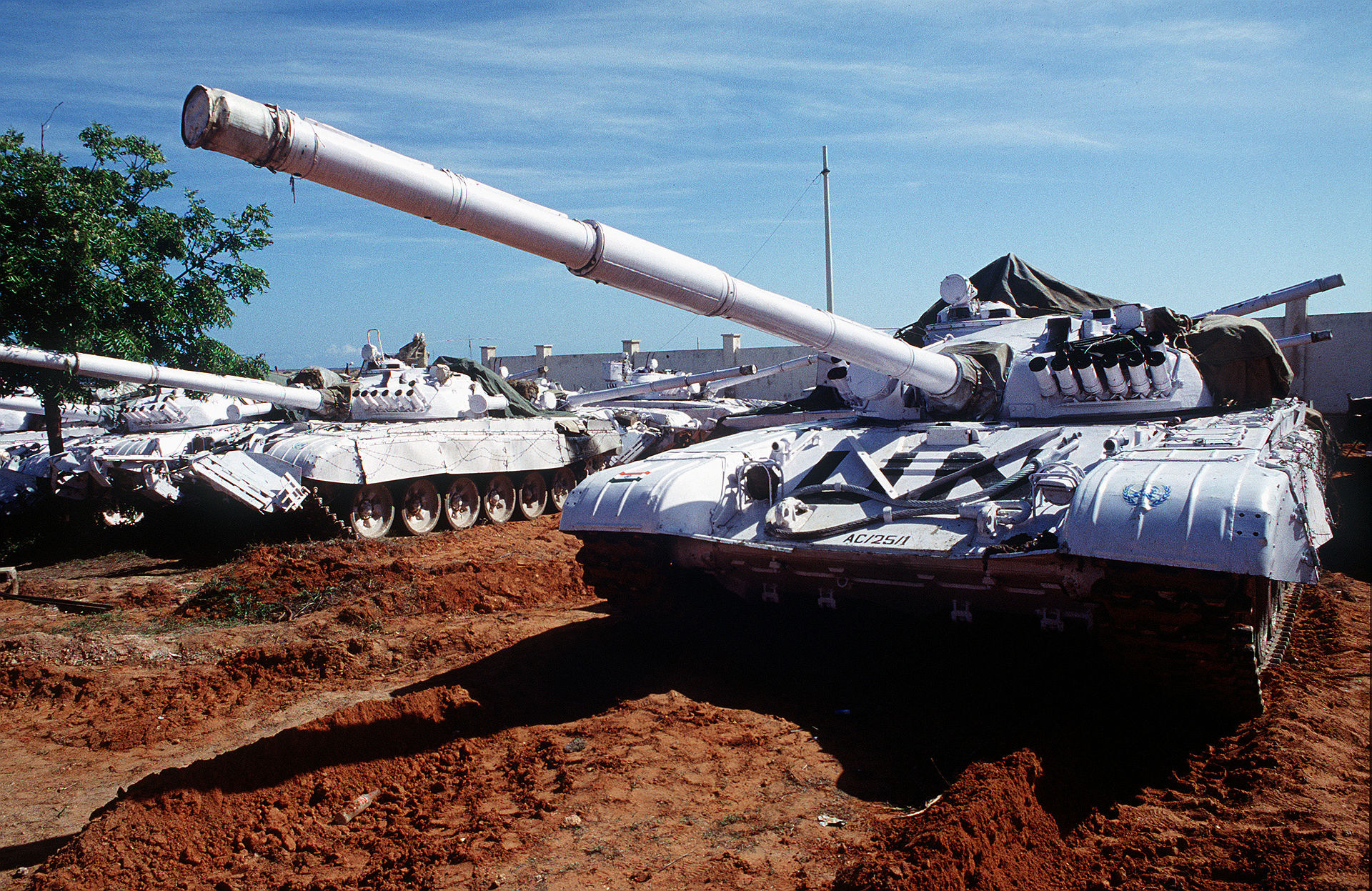
Indian T-72M1 MBT in UN service, Somalia
That is not to say that the Russians would not win the Indian contracts anymore. They did – in fact, the T-72 contract for India became one of the biggest ones and by the time the first Arjun prototype was ready, the T-72 was already chosen as India’s future Main Battle Tank and its production in Avadi was already underway. Politically, the adoption of the T-72 was an incredibly complex move because it happened around the time the Soviets invaded Afghanistan (an action that was condemned world-wide), but was, once again, somewhat forced upon India because the United States (specifically the Reagan administration) started once again to massively support Pakistan as well as radical Islamists (Mujahedeen) in Afghanistan with weapons in order to limit the Soviet influence on the region.
Seeing the threat of the Americans arming Pakistan with modern aircraft capable of delivering nuclear weapons (the threat of nuclear Pakistan would later indeed materialize) left India little choice but to turn to the Soviets for military equipment. Additionally, the deal included technology transfers and regular updates thereof.
It is therefore no surprise that the plans to build an indigenous MBT were put on a backburner. Between 1974 and 1982, little progress was made and numerous issues were encountered. The biggest problem during this stage was the armor, the engine and the suspension.
Initially (until 1976 or so), the Indians sought to purchase an existing power pack (a combination of engine and transmission) but this quickly turned out to be a bust, which is why the DRDO (Indian military research agency) tried to develop its own engine and suspension. This turned out to be a disaster.
The thing about engines and armor in real life is – it’s not that hard to copy an existing design, or build armor with a specific layout. The really hard part is to get to know the exact metallurgic processes that give each component its desired properties. This is the real know-how that the Indians failed to adopt, leading to a decade of incorrectly cast engine cylinders, cracked camshafts, bad welding techniques and brittle armor plating. One does not easily copy these manufacturing techniques – even with top of the line industry packed with experts, which the Indians did not have. As a result, the indigenous 1500hp unit was incredibly unreliable.
The attempts to build hydraulic suspension failed as well for the same reason – ironically, torsion bars were rejected because of bad experience with those used on the Vijayanta. Incorrect manufacturing process led to the Vijayanta torsion bars being brittle and breaking every now and then and the military hated that.
But, despite all these issues, the Arjun did not go away. In fact, Krauss-Maffei helped India design it (despite the levels of India’s cooperation with the Soviets), which was why the publically unveiled tank resembled Leopard 2 visually. After all, the Leopard 2 MBT was one of the tanks competing in the late 1970s and early 1980s against the T-72 (the others being the British Chieftain 800 and the French AMX-40). Once again, the Indians preferred a lighter tank so the Leopard 2 was never really a serious contender and, realistically, neither was the Chieftain.

Arjun Mk.1
Of note was the blocky composite armor design called Kanchan, allegedly developed indigenously by the Defence Metallurgical Research Laboratory at Hyderabad (the armor was named after a district in that city). The exact composition of this armor is unknown but numerous sources put it in relation with the famous British Chobham armor. The same sources, however, also claim that the turret is so rectangular because this armor is impossible to be produced angled, which is obviously not the case for Chobham. Given Krauss-Maffei’s involvement in designing the Arjun, it’s quite possible that that the early variant of armor instead resembled internally that of the Leopard 2 MBT.
Several other accounts exist, of course, with the most popular being a list of layers of different hardness steels with ceramic inlays, but such a design would seem to be well beyond the capabilities of the 1980s Indian defense industry.
The early six Arjun prototypes weighed some 50-60 tons, had composite armor and were powered by German 1400hp MTU 838 Ka-501 diesel engines. The engines were paired with another German component, a Renk RK 304S automatic transmission, allowing for very decent maximum speed of 72 km/h (average off-road speed was some 40 km/h). The armament consisted mostly of 120mm indigenous rifled cannon. The gun was manually loaded and used two-piece ammunition. It’s worth noting that, contrary to popular belief, this cannon is not in any way related to the Chieftain or Challenger 120mm cannon and was truly developed indigenously. Why the Indians chose this particular solution instead of adopting a NATO standard 120mm smoothbore is a mystery.
Of special importance were the engines. As you might have noticed, these were not the Leopard 2 engines (MTU 873 Ka-501 producing 1500hp). These MTU engines were based on older technology and were derived from the Leopard 1 series. This made them expensive because, unlike the 873 series, these were developed specifically for the Arjun and were never mass-produced. As such, the cost of each engine reached whopping 55 million rupees (at that time, roughly 1.5 million USD). The Indians were, of course, interested in the newer engines as well, but, allegedly, the introduction of the MTU 873 series would require the redesign of the entire hull. It seems, however, that the Indians managed to drive the price down after all because, according to some sources, they imported no fewer than 42 of these engines between 1983 and 1989 for roughly 15 million USD.
Between April 1984 and 1987, ten prototypes were built in total, of which six (later ones, presumably) were given to the Indian Army for testing while the other four remained with the CVRDE.
The testing unveiled a number of critical issues with the tank, specifically:
- The turret was so poorly designed that, if the driver was driving in an unbuttoned position (which was 99 percent of the time), traversing the turret would make its frontal armor hit his head, leading to serious injury
- It was impossible for the driver to use his escape hatch when the turret was facing forward (this issue was only resolved by redesigning a portion of the turret, which was done so poorly that it resulted in several shell traps)
- The FCS was nowhere near ready (or even fitted on the prototypes)
- Due to poor internal layout, it would take the loader at least 15 seconds to load the gun
- The anti-aircraft machinegun had to be operated by the loader, which meant that in case of an attack that required its use, the main gun would remain inoperable because the gunner would not be able to load it from his position
- Even with the loader fully committed to his task, the tank only had three rounds easy to reach in a ready rack and after spending them, the loading process became even slower (the Indian Army required 12 ready rack rounds but this demand was not met)
- At 60 tons, the tank was far heavier than the army had wanted (40 tons)
- Since it was so heavy, the tracks had to be wider than required by the army in order to maintain its mobility by reducing its ground pressure to acceptable levels, which meant that the tank would not fit on Indian transport trains and could not cross many bridges
- The engines were prone to overheating and their modifications to work in India’s harsh climate rose their unit cost considerably
As you can imagine, addressing core design issues such as these was neither easy nor cheap and by the time at least some were fixed, the cost of the program was 19 times higher than originally intended. What was even worse was the fact that 55 percent of each tank’s cost had to be paid in foreign exchange because 43 percent of all components of this “indigenous” tank were imported. In fact, only the basic hull and turret design were truly indigenous, otherwise:
- Engine and transmission were German
- Fire Control System was German
- Tracks were German (by Diehl)
- Primary gun sights were from the Netherlands
- Hydropneumatic suspension was American
At this point, it was quite clear that this was too little, too late. The design was now roughly 15 years old. What was even worse, India was plagued by internal strife (the 1984 assassination of Prime Minister Indira Gandhi and the massive Bofors scandal threw even the military in disarray) and the 1980s debt crisis caused additional financial problems for the country that would be made even worse by years of drought and the early 1990s oil price spike due to the Gulf War.

Arjun Mk.1
The T-72s had problems too – specifically, the lack of spare parts that could not be indigenously produced from scratch with imports from the struggling Soviet Union erratic at best. The cheapest option at that point was, once again, to attempt to upgrade the Vijayanta tanks.
By 1991, only 12 tanks (effectively hand-crafted prototypes) were built in total and the project was estimated to have cost around 2.8 billion rupees (approximately 116 million USD), of which 1.8 billion was, after an internal audit from 1989, discovered to have been wasted either on faulty components or corruption. Those were costs India could ill-afford.
Starting from 1987, the CVRDE designers were working on correcting the issues, the worst of which were those connected to the engines. Even with expensive modifications, the German engines performed extremely poorly in hot and dry weather of the Rajasthan desert, which was (based on the 1971 experience) considered to be the most likely place of tank battles with Pakistan. The engines would ingest sand and would work poorly with the Renk transmission. It would also overheat and the suspension was a mess by itself with practically every single part failing quality control (it was estimated that for each Arjun, 19 spare nitrogen cylinders would have to be available at any given time).
Additional problems included:
- Increased weight of the tank that severely reduced its mobility
- Unsuitable maintenance equipment
- The 120mm APFSDS round developed it was a failure
- The tank could not hit moving targets thanks to its problematic Fire Control System
- The Fire Control System provided poor readings in high temperatures
- Commander’s scope, MRS and rangefinder were deemed unreliable
Despite these issues, the tank was officially put through another round of trials in 1993 and despite the economic issues India was facing at the time the military proclaimed it wanted to have 1.500 of these tanks battle-ready by 2000. This was obviously not a realistic plan. Internally, everyone likely realized what a mess the Arjun program was, but this region of the world was and is to this day all about saving the face. And so another 3 billion rupees were allocated to it. In the meanwhile, India was locally producing the Russian T-72M1 in large quantities, still operating the Vijayanta and waiting for something better to come along.
The years went by with little progress made. Two prototypes with torsion bar suspension were built at some point between 1996 and 1998, but those fared even worse than the hydraulic suspension ones due to the poor manufacturing quality of the torsion bars.
On January 9, 1996, the Arjun was officially unveiled and cleared for mass-production (citing “excellent” results of domestic tests), which was launched on limited scale at Avadi at 3.3 million USD per vehicle (the order for the first 15 vehicles was placed in August of the same year).
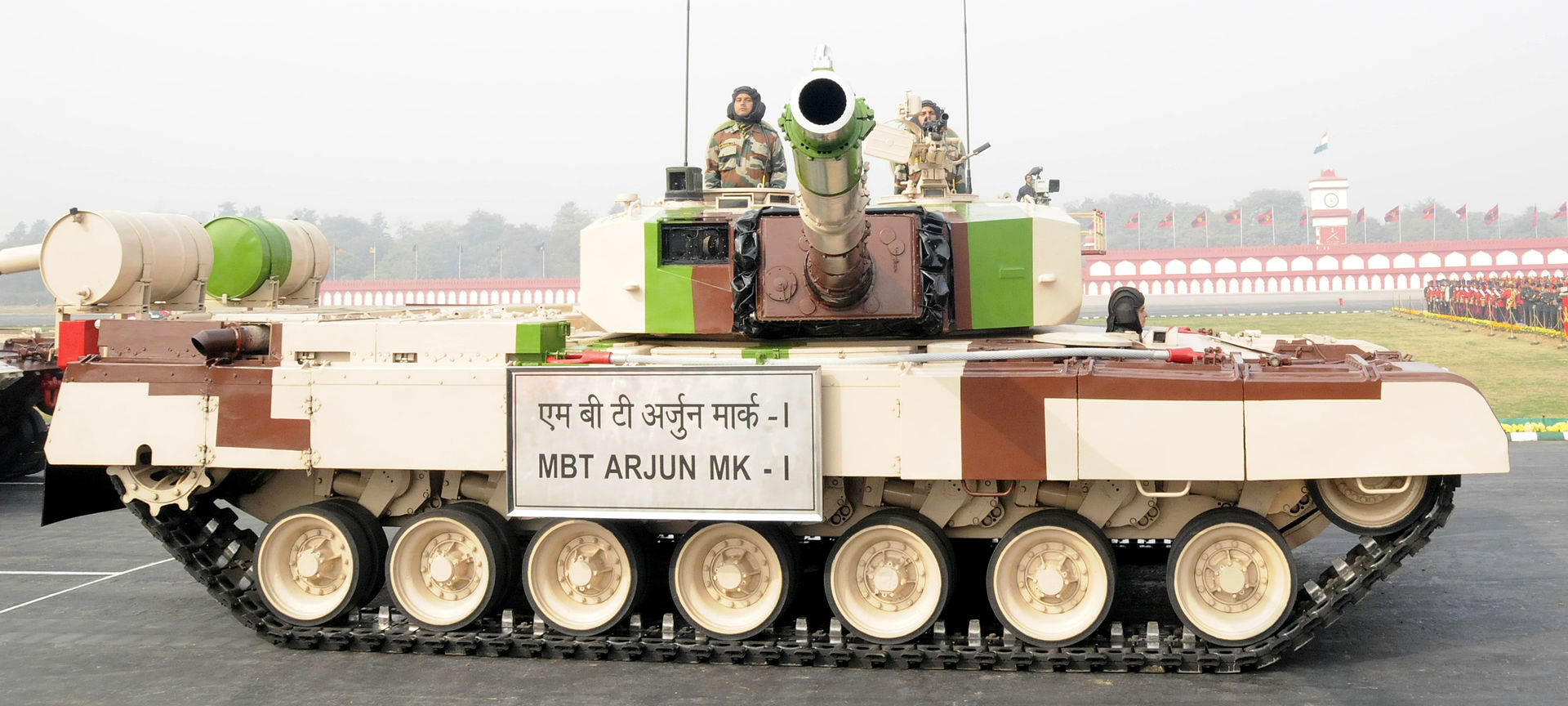
Arjun Mk.1
Once again, a plan was announced to have 2000 Arjun vehicles built after “the successful trials of the pre-production vehicles” (note the same pattern as Russia uses – a grand plan with unrealistic numbers and the “post-trial” condition), replacing all the older T-72s in Indian service. Various military analysts at the time were looking somewhat favorably at the design and it seemed that it would finally, after two decades, begin to mature.
By 1997, at least one Arjun tank appeared in public for the first time during the January 27 Republic Day military parade.
By 1998, 32 pre-production (effectively, once again, hand-crafted) Arjun MBTs were built in total. This number does not include 12 initial prototypes or the Arjun Mk.2. The issues with the engine were never completely resolved (despite claims otherwise), nor was it possible to mass-produce it locally (MTU claimed in 2001 to have an exclusive contract for its manufacture). At the same time, the defense budget was shrinking and it was estimated that no serious production would take place until 2002 or even 2004. Ironically, by August 1998, the project also lost a number of key researchers and developers to the foreign private sector. In the meanwhile, India quietly started ordering hundreds of T-90S tanks from Russia.
By 1999, despite the planned acquisition of the Russian T-90 tanks, 425 million USD were allocated once again to the Arjun program in order to build 124 (some sources claim 125) tanks in the Heavy Vehicle Factory in Avadi by 2003. However, at this point, the cancellation of the entire Arjun program was discussed very vocally – with the modernization of the Indian T-72 series and the T-90 production, it was believed that India could simply not afford to support yet another MBT.
At this point, the whole program was turning into a farce and various sources state various things. What can effectively be surmised is this:
The first of the ordered 124 tanks were delivered by mid-2004 and what the Indians definitely accomplished was arming one full regiment with the Arjun tanks (45 vehicles in total) by 2009. Some sources claim that the whole batch was eventually built while others state only 62 more were produced by 2010. By 2007, the Arjun tanks took place in the Ashwamedha exercise in the Rajasthan desert and it was an absolute shitshow. All the issues that were claimed to be fixed manifested in full, including the reported inaccuracy, suspension problems and the ever-popular overheating. The fun continued in 2008 during another round of exercises where the tanks were so terribly that the Indians were attempting to actually blame the engine issues on sabotage.
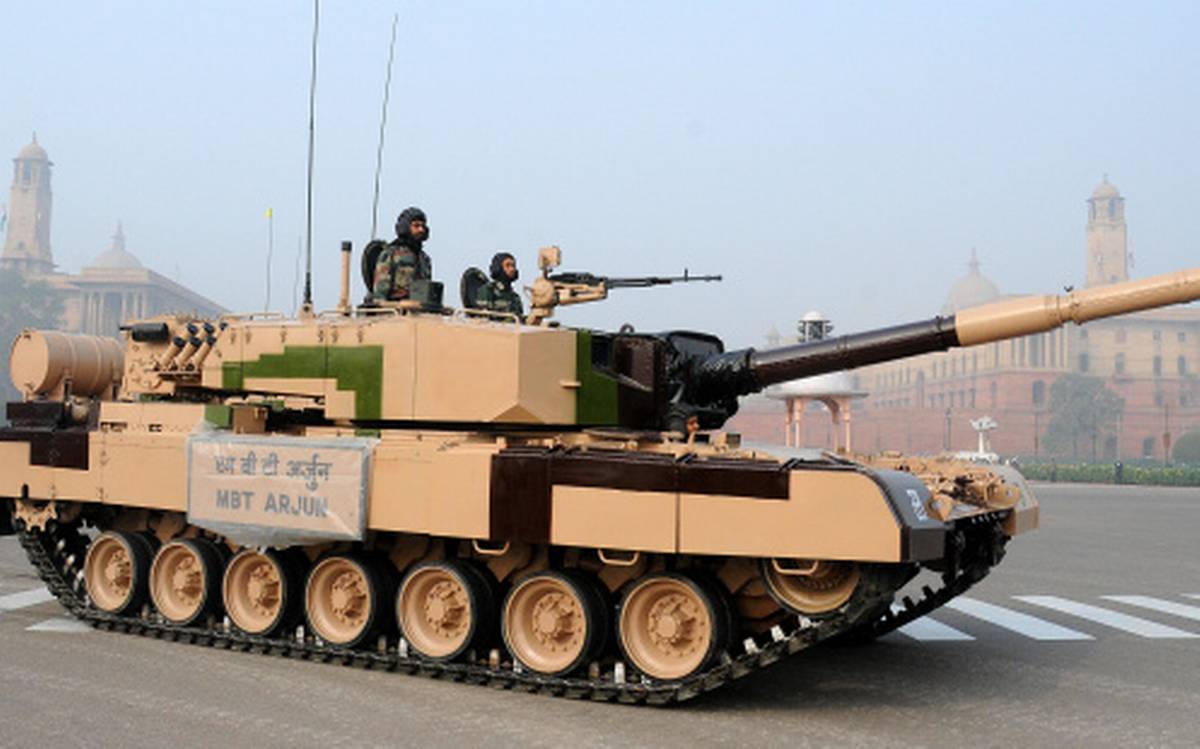
Arjun Mk.1
The MTU experts who were presents confirmed that someone tampered with the engines and transmissions, but it was far more likely that any damage was caused by inept maintenance or attempts to “improve” the performance, kind of like when a young adult puts a spoiler wing on his car because “those idiots at the factory have no idea what they are doing.” As it turned out, the Germans did have an idea what they were doing and were pissed. As a direct result, a black box-like device was installed in the engine to record any and all “unauthorized setting changes”.
But the Indian Army had about enough of this mess. The crews hated the tank, the military hated it too and, as a result, a decision was taken in July 2008 not to purchase any more Arjun MBTs. Ever. Another deal with the Russians was signed instead, including some T-90 technology transfer.
This apparently caused some serious political ripples and several “objective comparative trials” were organized in 2010 to prove that the Arjun was “better than the Russian T-90.” How objective have the trials been is anyone’s guess. The reports bear the mark of pro-Arjun bias (for example by calling upon 500 Arjuns to fill the role of first-line assault tanks) even though some issues are still noted, such as the fact that operating 60-ton tanks as a spearhead when no bridges can support them may just not be such a good idea.
But, otherwise, everyone was trying to just make this thing go away. Three years later, by 2013, an internal Indian report stated that most of the Arjuns are not operational due to the lack of spare parts.
There was also the issue what to actually do the legacy of such an incredibly expensive program because 35 years of development with nothing to show for, well, that would just cost a lot of people their careers. And what do you do when you have a giant money sink on your hands? Naturally, you start the development of a Mk.2 version!

Arjun Mk.2
Fortunately, the Indians were quite sensible here and asked for help. The Arjun Mk.2 was co-developed in cooperation with the Israeli company Elbit and it shows. Around a hundred improvements were made over the original tank and would successfully pass its trials by 2012. You probably won’t hear them say this in public but what actually happened was that the Indians hired the Israelis to rebuild the tank for them and they did that in less than two years.
This version would include:
- Improved Kanchan armor
- Improved suspension (including final drive, tracks and sprockets)
- Improved Fire Control System and other devices
- Better ammunition for the main gun
- Safer ammunition racks
- Soft-kill APS (albeit an ad-hoc one, basically a LWR connected to smoke grenade launchers)
- Lower weight (reduced from 60 tons to 55 tons)
And that was it. Not much happened since. Another version (Arjun Mk.1A) was also developed and shown to public recently (in 2019), but it’s not really clear whether it’s the same tank or the Mk.1 tank brought up to the Mk.2 standard plus some other minor upgrades (the latter is more likely).
However, it seems that the Arjun is just not finished yet. During a recent interview from January 2020, army chief Manoj Mukund Naravane told the press that Arjun Mk.2 would reach operational status by 2025-2026. It seems the comedy that is the Arjun program is to have yet another act.
What do you think of the article, commanders? Did you like it? Would you like the series to continue? Would you like us to introduce the Arjun, or more like show bobs and Vijayanta? Let us know on our official Discord and, as always:
See you on the battlefield!




